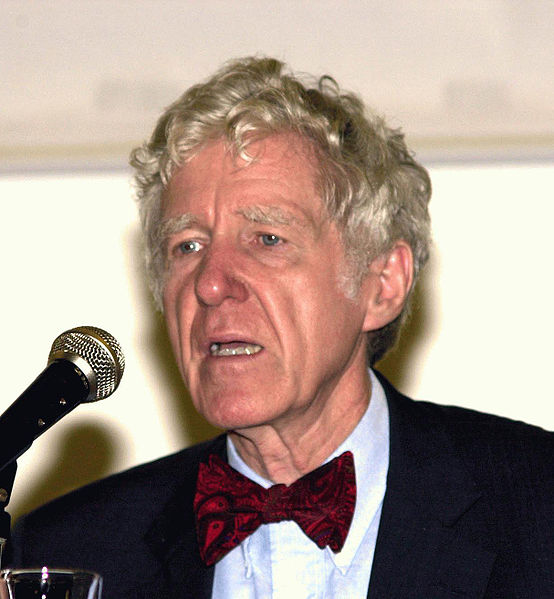Sustainable development
Establishment of the concept of sustainable development
In this chapter, we are seeking the answer to the question what the concept of sustainable development means, and why a need of humankind emerged towards a solution like this. It can be stated that the concept of sustainable development is very closely related with the protection of the environment. Interest has been raised for environmental protection due to various environmental impacts and research results, and also directed attention to the importance of cooperation on a global scale.
In 1968, establishment of the Club of Rome was one of the answers concerning the solution of the emerged global environmental problems. The Club of Rome has 100 members from nearly 40 countries representing education, business, governments, science etc. In 1972, the report of Donella and Dennis Meadows titled “Limits to Growth” was published. This report stated that according to the model calculations of the authors the raw material and energy sources necessary for the survival of humankind might to be exhausted on a time span of a few generations and not in the distant future as suggested earlier. This work also warned that providing the increasing population of the Earth with drinking water and sufficient amount of food would be more and more challenging. Nowadays the population of the Earth is around 7 billion, and appropriate provision of water and food is one of the greatest challenges for humankind. Authors also thought that a global environmental disaster might commence at the middle of the 21st century. Their solution proposals were directed towards the limitation of economic growth, which established the concept of zero growth. The idea of zero growth states that development should have been stopped where it stood, and thus our fundamental problem arising from the overuse of materials and resources. This should have caused the conservation of the current status quo, level of development, and as such it has been heavily opposed by the developing countries who expressed their opinion that everyone has the right to development and growth, and no one, especially not the developed countries have the right to prevent them in this effort. One of the great merits of the idea was that it proved to be an incentive for new professional debates and working out of possible solutions, models.
In 1981, the wording of sustainability was first published by Lester R. Brown in his work on sustainable society. In this work, sustainable society was based on the least possible deterioration of environment (in both the sense of quality and quantity) caused by population growth and usage of natural resources.
Lester R. Brown (1934-)
In 1983, pursuant to the resolution of the United Nations General Assembly, the World Commission of Environment and Development has been established led by chairwoman Gro Harlem Brundtland. The Committee had 23 members; Hungary was represented by academician Professor István Láng.
Professor István Láng gave a presentation in the television programme University of Omniscience (Mindentudás Egyeteme) at 11th November 2011 titled “Environment – sustainable development”.
In 1987, the Brundtland Committee published its report titled Our Common Future that had since become generally known. In this work, the Committee outlined the global vision of sustainable development and the core elements of its realization. According to their idea, this vision can be characterized as an economic growth of such a type that takes into consideration the conservation of natural resources and also might present a solution for the problem of the developing countries. This report gave a very short and concise definition of the concept of sustainable development:
"Sustainable development is a development that meets the needs of the present without compromising the ability of future generations to meet their own needs " .
Beyond introducing the concept of sustainable development, the Committee’s report also set the principles required for the realization, mentioning the following aspects listed below:
- Respect and protection of communities.
- Improvement of the quality of human life.
- Conservation of the vitality and diversity of Earth.
- Minimizing use of non-renewable resources.
- Growth should not exceed the supporting and regenerating ability of Earth.
- Change of individual behaviour and habits.
- Providing the right to human communities to take care of their own environment.
- Establishment of national cooperation for the integration of development and protection.
- Enforcement of a global consensus.

Title page of the report titled Our Common Future
Later sustainable development also appeared in various conferences, scientific research etc. and it has been built in strategic visions and action plans as well. Since Lester R. Brown first published the wording „sustainable” (in a societal aspect: sustainable society), and the Brundtland Committee had finished its work (1987), the explanation „sustainable development” spread with tremendous speed; however, intentions were in reality hardly realized by actual steps. Decent proofs are the events of the UN conferences arranged in Rio de Janeiro (1992), Johannesburg (2002) and again Rio de Janeiro (2012). This can be explained with the hardships of the interpretation of the integrant concept of sustainable development, conflicts of interests and the sluggish pace of moving away from the global and philosophical level.
Different interpretations of sustainable development
The Brundtland definition of sustainable development has been published in 1987 and since then became the most generally known definition of the concept. A decent question may emerge concerning how much the need to satisfy the „present need” in the definition has changed in the decades following the publication of the definition, but also the effects of a plenty of other external limiting factors must be taken into consideration: climate change, globalization and the change of various resources and biodiversity.
Differing from the wording of Brundtland, it was proposed at the Conference of Scientific Academies (Tokyo, 2000) that it would be better to speak only about sustainability and words like development or improvement should be left out. In this definition of sustainability the expressions of environment and natural resources can be found as new elements. This means that the goal of sustainability is humankind itself, i.e. the long-term existence of society and the improvement of social well-being and the improvement of the conditions of human life.
Literature states as a basic principle that representatives of weak sustainability hold the position that human capital is directly substitutable for natural capital. This means that the aspect of weak sustainability assumes the unconditional substitutability of nature.
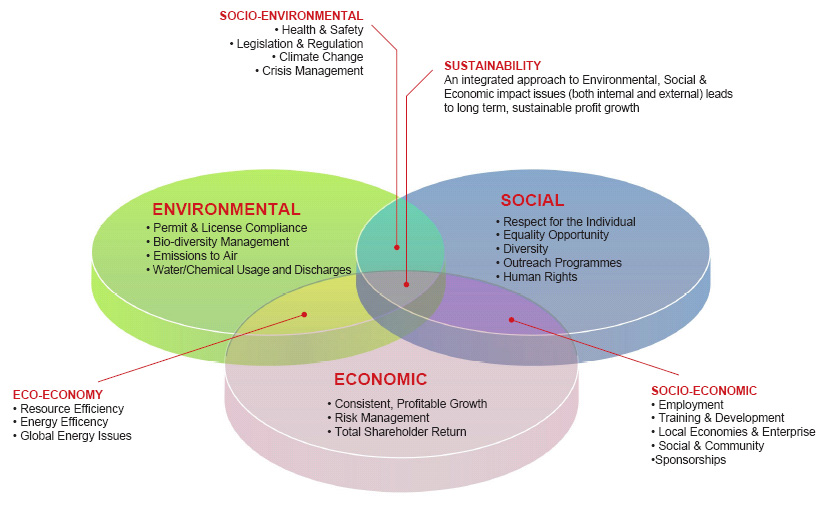
Interpretation of weak sustainability
It comes from unconditional substitutability that the point of this approach is that if the sum of capital is left constant over time, sustainable development is achieved. So the value of aggregate capital must be left constant regardless of the types of capital. Followers of the weak sustainability approach think that the decrease of the value of some components is acceptable if the values of some other component show equal growth, substituting the decreasing capital stock.
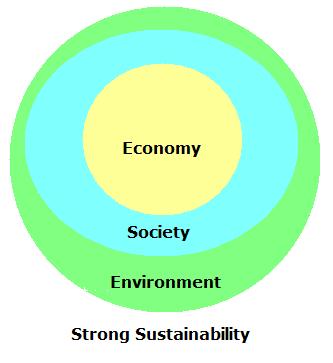
Strong sustainability
According to the concept of strong or strict sustainability, natural resources can only be replaced by economic capital in a limited extent, and not in an unconditional, unlimited way. See figure above. In this case, conservation of the full natural capital has primary importance. The substitutability of natural and man-made, artificial capital is limited.
The third way of interpretation is environmental sustainability. According to its representatives, the goal is not only the conservation of the full value of capital, but also the maintenance of level of incomes and services originating from individual natural resources.
Levels of sustainable development
Earth is a complex system consisting of many subsystems showing very complicated interactions. At first sight, these subsystems form independent groups; however they shape our planet through their interactions. It is a global system of interrelations, since even a regional problem can have implications on other continents as well: just think on the example of air pollution. It can be experienced in numerous cases that consumer habits exert their effects not on the spot of the consumption but somewhere else, and this phenomenon is greatly supported by globalization processes.
Beside international and domestic sustainability events, it can’t be disregarded that those strongly committed to the protection of nature and environment raise their anxious words again and again for the sake of the cause. Their concept can be supplemented today with sustainability, climate change and globalization. Altogether it can be stated that sustainability can’t be realized disregarding the interrelations and interactions of climate change and globalization.
The European Union can be considered as a leader in the realization of the idea of sustainability when we just think of the fact that the requirement of realizing sustainability is present in almost each and every main document. This is inevitable for practical accomplishment of this goal, and therefore incorporated also in the Treaty of Maastricht (Maastrichti Szerződés (1992)) or in the Fifth European Community Environment programme: „Towards sustainability” (1993-2000), in which the EU made a commitment to sustainability.
According to the evaluation of results of EU Sustainable Development Strategy achieved to these days, the exact improvements can be considered as moderate, however, even on Community and Member State levels, a significant development of relevant policies could have been observed.
Programs, ideas of global, regional, national and local levels work typically in an isolated way. In the sake of convergent operation, an organizing principle interlacing the programs of various areas and not decreasing their efficiency would be needed. This common organizing principle might be embodied by the concept of sustainability.
Employment, healthcare, environmental, agricultural and touristic program worked out on a regional level strive to reach synergy. There are multidimensional synergic effects that influence the efficiency of each other in the sense of multiple areas. However, it can also actually happen that the realization of one of the programs seriously deteriorated the efficiency of another. Analysing the content and levels of sustainability it can be perceived that local level is where advance might be easier, since it can be assumed that wide-scale realization of sustainable improvement is really important for the inhabitants of a settlement or a microregion.
The emergence of today’s global financial-economic crisis might provide a further support for the importance of local level. This is supported by the book of Schumacher (1974) titled „Small is beautiful”, which underlines the selection of appropriate size and scale in politics, economy and society.
Chapter 28 (titled: Local authorities’ initiatives in support of Agenda 21) of „AGENDA 21” accepted in 1992, in Rio de Janeiro deals with the local program of sustainable development and the decisive role of local authorities. The local program of sustainable development (Local Agenda 21 – „LA 21”) aims to create accordance of the nature-economy-society triangle in a local and microregional level in a way that it should serve the long-term ideas of sustainable development. Local Agenda 21 is a complex system organising and operating program built on the strict interpretation of sustainable development.
Dimensions of sustainable development
In early stages, the one-dimensional concept attempted to define sustainability from the aspect of the exploitation of natural resources. One-dimensional models mostly considered the ecological limitations and environmental aspects.
The next step was the appearance of the two-dimensional models. And since welfare and well-being are also incorporated in the goals of sustainable development, social-economic aspects also received spotlight. Welfare is related to the standard of living, while well-being expresses the feeling of happiness or content among given conditions. Nowadays it becomes more and more obvious that development can’t be expressed in the terms of increasing production and material wealth mostly at the price of destroying the nature or environment, since we are feeling worse quite often besides increasing GDP and seemingly growing wealth. The formerly known tools for environmental conditions were also supplemented, e.g. the tools of environmental policies supporting sustainability, set of values of sustainable society, etc.
Currently, the three-dimensional model is the most widely used (see figure below), and the three dimensions are represented by biosphere, society and economy. These models attempt to interpret the interactions of the three dimensions from the aspect of sustainability.
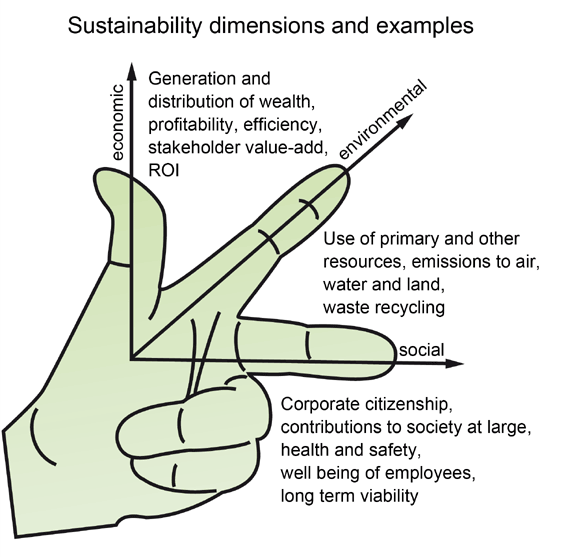
Various sustainable development strategies
The EU Strategy for Sustainable Development
The Strategy for Sustainable Development of the European Union was accepted in 2001, Gothenburg, and was first reviewed in 2005. The Renewed EU Sustainable Development Strategy is on track since July 2006. This strategy is built on the three pillars; therefore it aims economic development, environmental balance and social advance at the same time. To reach these three goals, such proposals were drafted that policies should serve sustainable development.
As key objectives, tasks managing global environmental problems posing the greatest challenges are detailed in the Strategy, as follows:
- global climate change,
- diseases endangering public health,
- problems of chemicals and food safety,
- poverty,
- ageing of population,
- inappropriate management of natural resources (decrease of biological diversity, soil erosion, increase of the quantity of waste materials),
- increasing traffic and its impacts, regional inequalities.
To manage the problems above, the Strategy proposes exact measures, action programs. To reach sustainable development, political changes are needed in EU and Member State levels. Primary objectives can be summarized as follows:
- strengthening the coherence of EU policies,
- appropriate pricing that serves as a signal for individuals and enterprises,
- scientific and technological investments for future improvements,
- improved communication among population and companies,
- enlargement and global dimension also must be taken into consideration.
Coherence of multiple EU policies means the sustainable development must become the central objective of each and all sectors and policies. Besides, it has to incorporate economic, environmental and social impact assessments inside and outside of the EU. These impact assessments serve as important information sources for decision makers for the preparation of proposals, thus risks of decisions can be minimized.
Appropriate pricing provides an incentive to the development of eco-friendly products and services. Besides, it is also important to stop financial funding that encourages the wasteful exploitation of natural resources and abolish the price of pollution.
Innovation is one of the most important objectives that help adjustment to sustainable development, development of eco-friendly tools and technologies that do not pose harm to human health.
Improvement of communication facilitates acceptance of various social layers towards decisions made for advancing sustainable development. With the help of publicity, dialogue and education, making groups of society interested in the manifestation of sustainable development on local level can be accomplished. This is because local, microregional level plays an important role in the realization of the goals of sustainable development. Education can increase the responsibility what individuals and communities feel towards environment. Furthermore, communication towards companies is very important, since companies must be motivated to incorporate environmental and social aspects into their economic activities. Sustainable development can only be realized if the solution of global, long-term objectives can be delivered to the levels of individuals, households, companies and policies.
Regional and local sustainability strategy
Chapter 28 (titled: Local authorities’ initiatives in support of Agenda 21) of „AGENDA 21” accepted at 14th June 1992, in Rio de Janeiro deals with the local programs of sustainable development. Local Agenda 21 (LA-21) programs are built on the strict interpretation of sustainable development. The main idea of the strict interpretation is that natural capital can be replaced by economic capital only in a limited way. Therefore, these programs must serve the interests of sustainable development in accordance with the nature-economy-society triangle, at a local level and in a long term (assessing the interests of at least three generations). These are complex programs, not identical with the environmental programs but incorporating them, and they also must interlink perspective with the global dimension. Main steps of LA-21 programs are shown by the figure below.
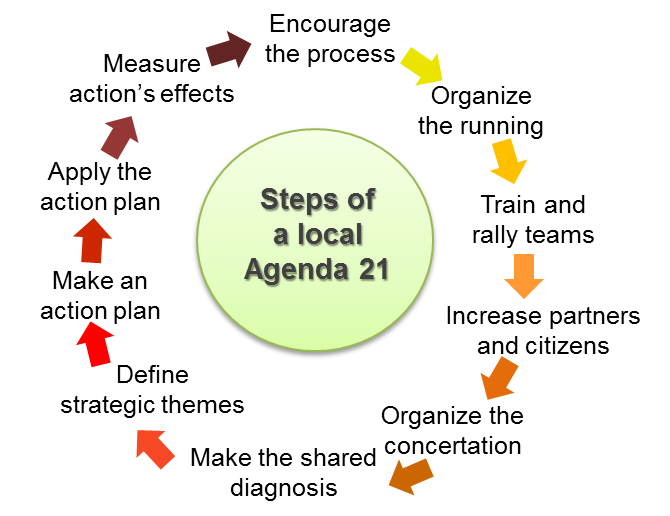
Steps of Local Agenda 21
The Local Agenda 21 process can be interpreted at multiple levels:
- in a narrow sense it’s just like a strategic plan or program, that is embodied in a tangible document and contains an action plan,
- in a broad sense, as a process of creating and realization of the strategy,
- and according to the broadest interpretation, LA-21 is a way of thinking, agriculture, lifestyle, way of life interwoven by the idea of sustainable development that appears in political culture and the work of local authorities (e.g. in local regulative work).
Local authorities play a principal role since local authorities are connected to the local communities in the strongest way. It is important to mention International Council for Local Environmental Initiatives, an international organization established in 1990 with the cooperation of local authorities. The Council also participated in the drafting of the basic document, and has been playing an important role in the support of local initiatives ever since then. The community preparing LA-21 is led by ICLEI, the work is supported by guidance, and working out of methodologies.
Sectoral sustainability strategy
This chapter introduces the complex concept of sustainable tourism, which can be explained by the fact that tourism is often involved today in development plans as a take-off point; and it can be decisive which parameters are considered during the realization of the development of the sector.
This topic has a broad literature, therefore a vast number of different definitions and approaches can be found. According to the approach of World Tourism Organization’s (WTO), guidelines and management processes concerning the development of sustainable tourism are applicable in case of all destinations and forms of tourism, involving mass tourism and different types of niche tourism. These principles incorporate environmental, economic and social aspects concerning the development of tourism, and their balance should secure long-term sustainability.
Thus, sustainable tourism should:
- make optimal use of environmental resources that constitute a key element in tourism development, maintaining essential ecological processes and helping to conserve natural heritage and biodiversity,
- respect the socio-cultural authenticity of host communities, conserve their built and living cultural heritage and traditional values, and contribute to inter-cultural understanding and tolerance,
- ensure viable, long-term economic operations, providing socio-economic benefits to all stakeholders that are fairly distributed, including stable employment and income-earning opportunities and social services to host communities, and contributing to poverty alleviation (UNEP WTO 2005).
It can be clearly seen from the points mentioned above that the relation between tourism and sustainability is quite complex, since it is affected by environmental, social and economic effects as well (Puczkó-Rátz 2001). Therefore, tourism should be in accordance with efforts directed towards nature conservation and must not exploit natural and social resources (Dávid-Baros 2009). Besides, the general condition of the environment has to be maintained, and the benefits of tourism should be extended to the whole society, and a high level of tourist satisfaction also must be maintained of course (Inskeep 2000).
Sustainable tourism development requires the informed participation of all relevant stakeholders, as well as strong political leadership to ensure wide participation and consensus building. Representatives of governmental and non-governmental organizations, tourism industry, tourists and local inhabitants must be involved (UNEP WTO 2005) (Puczkó-Rátz 2001). Achieving sustainable tourism is a continuous process and it requires constant monitoring of impacts, introducing the necessary preventive and/or corrective measures whenever necessary. Sustainable tourism should also maintain a high level of tourist satisfaction and ensure a meaningful experience to the tourists, raising their awareness about sustainability issues and promoting sustainable tourism practices amongst them. (UNEP WTO 2005).
References
Dávid Lóránt, Baros Zoltán: Environmentally sustainable tourism: international and Hungarian relations. Gazdálkodás, 2009, Évfolyam LIII., Szám 23. pp. 80-91.
Inskeep Edward: A fenntartható turizmus fejlesztése. Budapest Geomédia szakkönyvek 2000 185p. ISBN 963 7910 64 6
Meadows, D. (1974). The Limits to Growth, Second Edition Revised, Signet. ISBN 73-187907, pages 99-101
Puczkó László, Rátz Tamara: A turizmus hatásai. 2. átdolgozott kiadás Budapest Aula Kiadó 2001. 482 p. ISBN 963 9345 11 3
World Tourism Organization (WTO) – United Nations Environment Programme: Making Tourism More Sustainable, A guide for policy makers. 2005 pp.11-12
